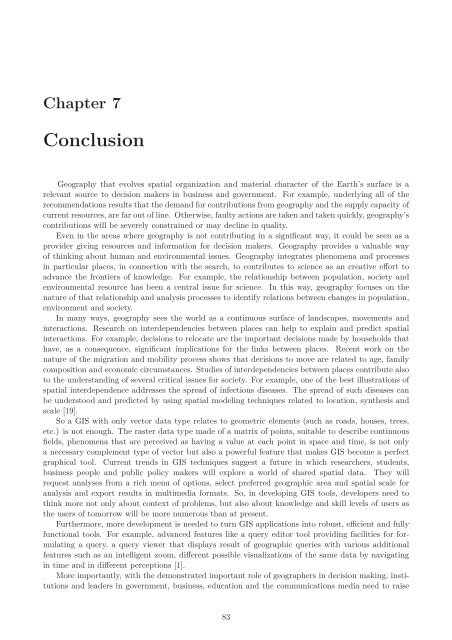PostGIS Raster : Extending PostgreSQL for The Support of ... - CoDE
PostGIS Raster : Extending PostgreSQL for The Support of ... - CoDE
PostGIS Raster : Extending PostgreSQL for The Support of ... - CoDE
Create successful ePaper yourself
Turn your PDF publications into a flip-book with our unique Google optimized e-Paper software.
Chapter 7<br />
Conclusion<br />
Geography that evolves spatial organization and material character <strong>of</strong> the Earth’s surface is a<br />
relevant source to decision makers in business and government. For example, underlying all <strong>of</strong> the<br />
recommendations results that the demand <strong>for</strong> contributions from geography and the supply capacity <strong>of</strong><br />
current resources, are far out <strong>of</strong> line. Otherwise, faulty actions are taken and taken quickly, geography’s<br />
contributions will be severely constrained or may decline in quality.<br />
Even in the areas where geography is not contributing in a significant way, it could be seen as a<br />
provider giving resources and in<strong>for</strong>mation <strong>for</strong> decision makers. Geography provides a valuable way<br />
<strong>of</strong> thinking about human and environmental issues. Geography integrates phenomena and processes<br />
in particular places, in connection with the search, to contributes to science as an creative ef<strong>for</strong>t to<br />
advance the frontiers <strong>of</strong> knowledge. For example, the relationship between population, society and<br />
environmental resource has been a central issue <strong>for</strong> science. In this way, geography focuses on the<br />
nature <strong>of</strong> that relationship and analysis processes to identify relations between changes in population,<br />
environment and society.<br />
In many ways, geography sees the world as a continuous surface <strong>of</strong> landscapes, movements and<br />
interactions. Research on interdependencies between places can help to explain and predict spatial<br />
interactions. For example, decisions to relocate are the important decisions made by households that<br />
have, as a consequence, significant implications <strong>for</strong> the links between places. Recent work on the<br />
nature <strong>of</strong> the migration and mobility process shows that decisions to move are related to age, family<br />
composition and economic circumstances. Studies <strong>of</strong> interdependencies between places contribute also<br />
to the understanding <strong>of</strong> several critical issues <strong>for</strong> society. For example, one <strong>of</strong> the best illustrations <strong>of</strong><br />
spatial interdependence addresses the spread <strong>of</strong> infectious diseases. <strong>The</strong> spread <strong>of</strong> such diseases can<br />
be understood and predicted by using spatial modeling techniques related to location, synthesis and<br />
scale [19].<br />
So a GIS with only vector data type relates to geometric elements (such as roads, houses, trees,<br />
etc.) is not enough. <strong>The</strong> raster data type made <strong>of</strong> a matrix <strong>of</strong> points, suitable to describe continuous<br />
fields, phenomena that are perceived as having a value at each point in space and time, is not only<br />
a necessary complement type <strong>of</strong> vector but also a powerful feature that makes GIS become a perfect<br />
graphical tool. Current trends in GIS techniques suggest a future in which researchers, students,<br />
business people and public policy makers will explore a world <strong>of</strong> shared spatial data. <strong>The</strong>y will<br />
request analyses from a rich menu <strong>of</strong> options, select preferred geographic area and spatial scale <strong>for</strong><br />
analysis and export results in multimedia <strong>for</strong>mats. So, in developing GIS tools, developers need to<br />
think more not only about context <strong>of</strong> problems, but also about knowledge and skill levels <strong>of</strong> users as<br />
the users <strong>of</strong> tomorrow will be more numerous than at present.<br />
Furthermore, more development is needed to turn GIS applications into robust, efficient and fully<br />
functional tools. For example, advanced features like a query editor tool providing facilities <strong>for</strong> <strong>for</strong>mulating<br />
a query, a query viewer that displays result <strong>of</strong> geographic queries with various additional<br />
features such as an intelligent zoom, different possible visualizations <strong>of</strong> the same data by navigating<br />
in time and in different perceptions [1].<br />
More importantly, with the demonstrated important role <strong>of</strong> geographers in decision making, institutions<br />
and leaders in government, business, education and the communications media need to raise<br />
83
















